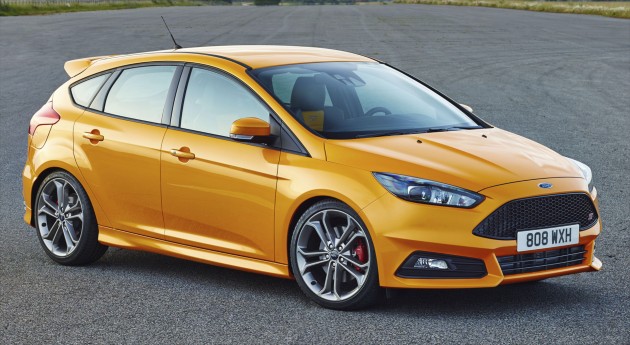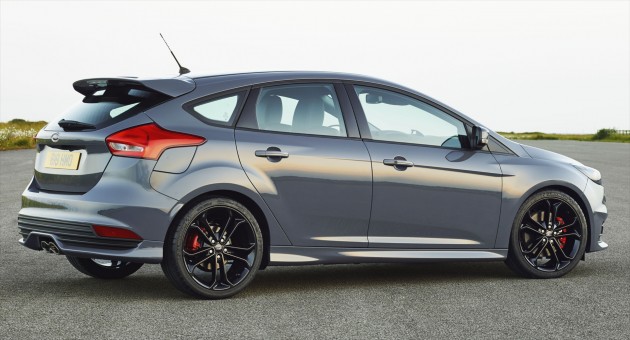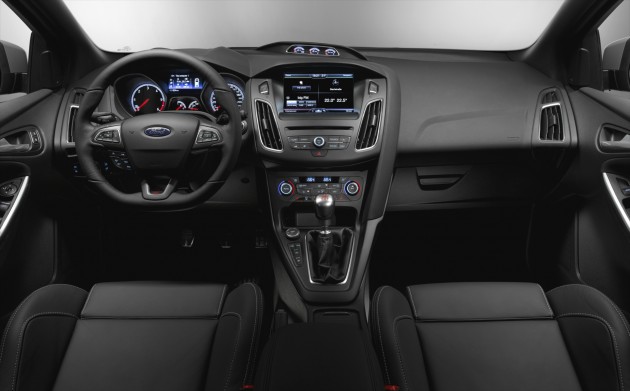
Ford has taken the wraps off its third-gen Focus ST facelift - the five-door hatch made its global debut today at Goodwood, and is scheduled to enter the market from early 2015. The mid-life rework for the C346 ST sees a redesigned, sportier-looking front as well as rear, along with a new wheel design in terms of exterior styling changes.
The car gets a slimmer design headlamp and a more dynamic-looking bonnet, as well as a new front bumper, which is deeper and has a revised upper honeycomb grille that sits higher and more upright – as suggested by earlier spyshots, the licence plate position now sits lower. The lower grill, in the meantime, has been made larger.
At the back, the rear bumper is also set deeper – the company says this helps emphasise the width of the car better. Otherwise, the centrally-mounted tailpipe remains. The 18-inch wheels carried over from the old car now gets dressed in a Rado Grey finish as standard, and a new 19-inch ST Design alloy wheel (and specially-engineered Michelin Pilot Super Sport tyre) goes on the option list for European versions.
In terms of exterior colours, European STs retain Tangerine Scream, Frozen White, Panther Black and Race Red from the pre-facelift, but Spirit Blue has now been replaced by a colour called Deep Impact Blue, and a new dark grey shade called Stealth has been introduced for the car. In the US, Magnetic Metallic replaces Ingot Silver in the palette - no mention of whether Performance Blue continues on or has also been changed, like in Europe.

Inside, the cabin gets minor layout changes in the same manner as that in the recent Focus facelift. There's a much simpler and cleaner centre stack, which now has a narrower profile and more uniform look as the console progresses compared to the pre-facelift.
The 12V socket has been relocated, now placed forward of the gearshift, and the handbrake lever has also been moved. In keeping with the new slimmer profile, the exposed wide-position dual cupholders of the original Mk3 have been replaced by a more streamlined tray, in which the cupholders are now positioned fore/aft, complete with a sliding cover. The car also gets a new flat-base steering wheel with a soft-feel leather covered rim.
As before, the ST comes in ST1, ST2 and ST3 trim levels, with changes being that HID headlamps - now with adaptive front lighting - are now standard from ST2 level onwards (previously, only ST3). In terms of Recaro seat finishes, the old specification continues on unchanged (ST1, full fabric; ST2, partial leather with base and side bolsters in body colours; ST3, fill leather).
In terms of powertrain, the existing 2.0 litre EcoBoost turbo mill has also been carried over – the new, and heavily revised 2.0 litre EcoBoost that was unveiled along with the Ford Edge a few days ago won't be seen until a much later point, if at all on the Mk3 ST. So it's the same 250 hp and 340 Nm (the 360 Nm quoted is, like before, on overboost) as seen on the current ST.

The big news is the introduction of a ST diesel version (no more STD jokes, please) in Europe, which is powered by a 185 PS 2.0 litre TDCi. It's based on the base 150 PS tune, the output increase for ST use achieved by electronic calibration, a revised air intake system and a new sports-tuned exhaust. The oil burner develops 400 Nm of torque from 2,000 to 2,750 rpm, and top speed for the ST diesel is 217 km/h.
Both engines use the familiar Getrag Ford MMT6 six-speed manual transmission, with a performance-oriented, short-throw shift. The suspension, meanwhile has been given a few alterations, with all-new front springs and sportier new shock absorber tuning front and rear. And there are also new engine mounts.
The calibration of the electronic power assisted steering and electronic vehicle control systems have also been revised. Now, the car features a quicker response from the variable ratio steering, improving turn-in and delivering better overall balance, and the torque vectoring control settings have also been revised.
The three-stage ESP also gets a new Electronic Transitional Stability function, which senses vehicle stability and driver inputs and intervenes as required to maintain optimal precision and control during rapid changes of direction at speed.



No comments:
Post a Comment